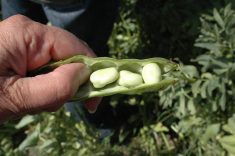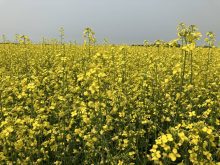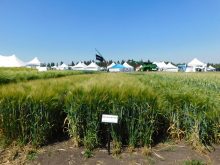If there’s enough crop-available moisture, putting on additional inputs could be a money-making proposition
You may not be able to make it rain, but you can make the most of the rain you get with a little help from soil moisture probes.
“When you know what’s happening below the soil surface and what’s there for soil moisture, there’s a lot of clarity that can be had,” said Kendall Gee, a senior agronomist with Crop Intelligence.
“We’re not setting out to predict yields as much as we would like to understand what your overall water-driven yield potential is. If you know that throughout the growing season, how can that help you optimize decisions?”
Read Also

New crop insurer policy enables easier startup for faba beans
Agriculture Financial Services Corporation updated its normals for faba beans, which may open the door for more Canadian producers to feel comfortable growing the pulse crop in the future.
The Saskatchewan company developed its Crop Intelligence app to work with on-farm weather stations. The units, which cost $3,000 and up, include a metre-long soil probe that has sensors continuously taking and transmitting moisture readings at several depths in the soil profile.
“You get a measurement at each, and you can watch as the crop starts to use water at each of those depths,” said Gee. “As it uses water, your total crop-available water starts to decrease, and the per cent soil moisture at each depth goes down.”
But what’s left is the key.
If there’s been a prolonged dry start to the growing season, the natural assumption is that the yield potential of your crops has been severely curtailed. Therefore, it would seem a waste of money to apply extra inputs, particularly fertilizer, on a crop that seems likely to be average at best.
However, that may not be the case.
“If it doesn’t rain, there’s not really anything you can do about it,” Gee said at the virtual Ag in Motion event last month. “But there is something pretty powerful in understanding where in your soil profile your soil moisture is and where your roots are active, and then using that information to help make some really key decisions throughout the growing season.”
The measurement of crop-available water alone isn’t enough to make those decisions — the company says farmers need to work with their agronomists and assess specific factors in their fields.
“Your actual yields reflect a combination of everything — genetic potential of the crop, the water that was there, and all the things you did throughout the growing season,” said Gee.
But some plants — such as wheat and canola — will send roots down as much as a metre to find moisture. That’s especially true in a dry year, said Gee, adding you may think there’s not enough water to sustain plant growth, but probing below the surface could tell a different story.
“A drought-stressed crop is going to drive down searching for water,” she said. “It’s interesting to be able to watch and understand what that crop’s capacity to tolerate a little bit of drought stress is — how we’re going to fare through a dry period at flowering depending on how much water is in the ground.”

Sophisticated soil moisture probes able to provide real-time data are powerful tools, said Curtis Russell, agronomic marketing regional manager at Taurus Ag.
“The more information you have to formulate a plan, it just gives you the opportunity to be more confident in what you’re doing,” said Russell.
“We sometimes see visual differences on top, but with (the probes), we can actually see under the ground and see that we’re driving roots with real data — not a five-gallon pail and a bucket of water.
“I love that I can have a real conversation based on real information. Farming’s full of hypotheticals already, and it’s already hard enough.”
In addition to using that data for decisions during the growing season (which could also include whether it’s worthwhile to spray for pests or diseases), it’s helpful to know how much soil moisture is left after harvest. When combined with past winter precipitation data, that fall moisture reading will give you a sense of how much soil moisture you can expect for the start of the next growing season, said Russell.
“I really love the fall reading,” he said. “For decisions in agriculture today, the ones that really matter and make the biggest difference are made in the wintertime.”















